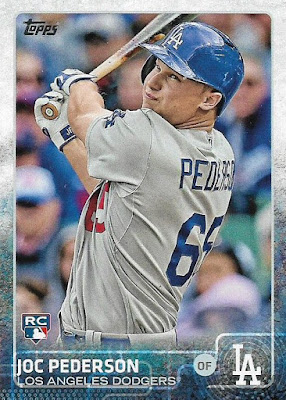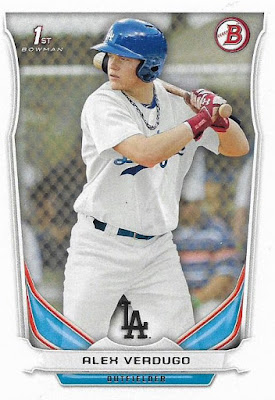I've written before about my high standards for baseball prospects as a kid collecting cards.
During the '70s and early '80s, prospects appeared on three- or four-player cards because back then there was a hierarchy, dammit. No prospect was getting an individual card.
I appreciated the rules at the time because I looked at the multi-player rookie cards as a proving ground. There was a pattern: appear on a multi-rookie card and then get your own card.
This was why I became so dismissive of players who appeared on multi-player cards multiple years. I've cited the Dale Murphy example repeatedly. How could he amount to anything? He had failed the pattern! Hello! Appearing on a multi-player card once means you appear on your own card the next year!
This was not realistic of me and obviously an inaccurate barometer of talent as Murphy went on to a long and productive career (just not as a catcher), even if his first solo Topps card wasn't until 1979.
Besides, there were other players who appeared on multi-player cards more than once. Kevin Pasley, who shared space with Murphy in 1977 is one example. Infielder Craig Reynolds, a multi-player card member in 1976 and 1977 is another. And there are several others going back to the 1960s.
Then there are the rookie prospects who show up on a multi-player card and then disappear only to reappear later. One of the best examples of this is Brock Davis, who first appeared on a multi-player prospects card in 1963 Topps (sharing cardboard with Willie Stargell). He then didn't appear again until 1971 on another multi-player card. Fortunately, Davis did get solo cards in 1972 and 1973. He just needed that '71 multi-player card to jump-start his career.
The example of the disappearing prospect that I remember is pitcher Larry Andersen, who younger collectors know only as the guy who the Astros sent to the Red Sox for prospect Jeff Bagwell.
Larry Andersen first appears on a multi-player rookie card in 1978 Topps, along with Jack Morris.
As a young collector, I would expect to see Andersen on his own card in the 1979 set. But he isn't in the 1979 set. There is no Topps card of him that year.
Instead he returns to Topps in the 1980 set, not with his own card, but on another multi-player prospects card. This was not a good sign.
Even worse, Andersen disappears again in 1981. No card of him that year.
Finally, Andersen gets his own card in 1982. Andersen's first solo card is in 1982 Topps and 1982 Donruss.
Donruss was less impressed, not even bothering to spell his name correctly.
But lest you think that relievers getting left out of Topps products is a modern invention, it took Andersen a few more years to become a regular in Topps flagship. He disappeared again in 1984 before returning for good in 1985.
So, the path to a solo card is not as carved in stone as I believed when I was 11 years old. I don't imagine it is any more certain these days, but I thought I'd take a look at a couple of Dodgers and see if I can gauge anything.
Today, prospects first show up in Bowman before they sniff a Topps cards (although I secretly appreciate any player who manages to skip Bowman entirely when first appearing on a Topps card). They don't have to share cardboard with anybody though.
In Joc Pederson's case, he first appeared in Bowman in 2012, in the prospects set, and receives a "1st Bowman card" stamp for his trouble. Collectors have a much more difficult time figuring out a player's first card these days, so we need our stamps.
The following year, Pederson didn't appear as a base card, but instead was in several insert sets and Bowman satellite sets, like Platinum.
In 2014, it was more of the same, inserts and spin-off sets like Sterling.
Pederson gets his first Topps solo card in 2015 with the rookie card logo to match.
That was the pattern for Pederson. It took three years of Bowman cards -- what I would guess might be three years of multi-player prospect cards back in the day -- before receiving a solo card.
The next year, he received a "future stars" notation on his solo card. I doubt Topps breaks out the "future stars" label on each player's second-year solo card, but it might be interesting to research.
Let's see another Dodger example:
Prospect Alex Verdugo has received limited time in the major leagues so far. His first Bowman appearance is in the 2014 Draft set.
Verdugo then "graduates" into the Bowman Prospect set in 2015, which is where Pederson started out.
Verdugo then appears in the Bowman Chrome Prospects set and several other spin-off Bowman sets and insert sets for 2016. He's not in the base prospects set.
Verdugo is limited to insert sets and satellite Bowman sets in 2017, but he's already had an extra year of Bowman when compared with Pederson.
Here is Verdugo's first solo Topps card, obviously arriving in 2018. Truthfully, based on my 1970s background, I don't think he deserves it. He has just 24 games in the majors, and even though he's a solid prospect, I can't help but think he would be on a three- or four-player panel if his career started in, say, 1975.
If I had the time, I'd go through a number of players to see if I could come up with a pattern and then compare the pre-Bowman era with the Bowman era. Maybe someday I will, but it's more likely I won't.
At least I got the wheels turning.
















Comments
As for better known players, Lou Piniella was on a multi-player rookie card in 1964, 1968, and 1969.
I always enjoy your blogs. Thanks for sharing your thoughts!